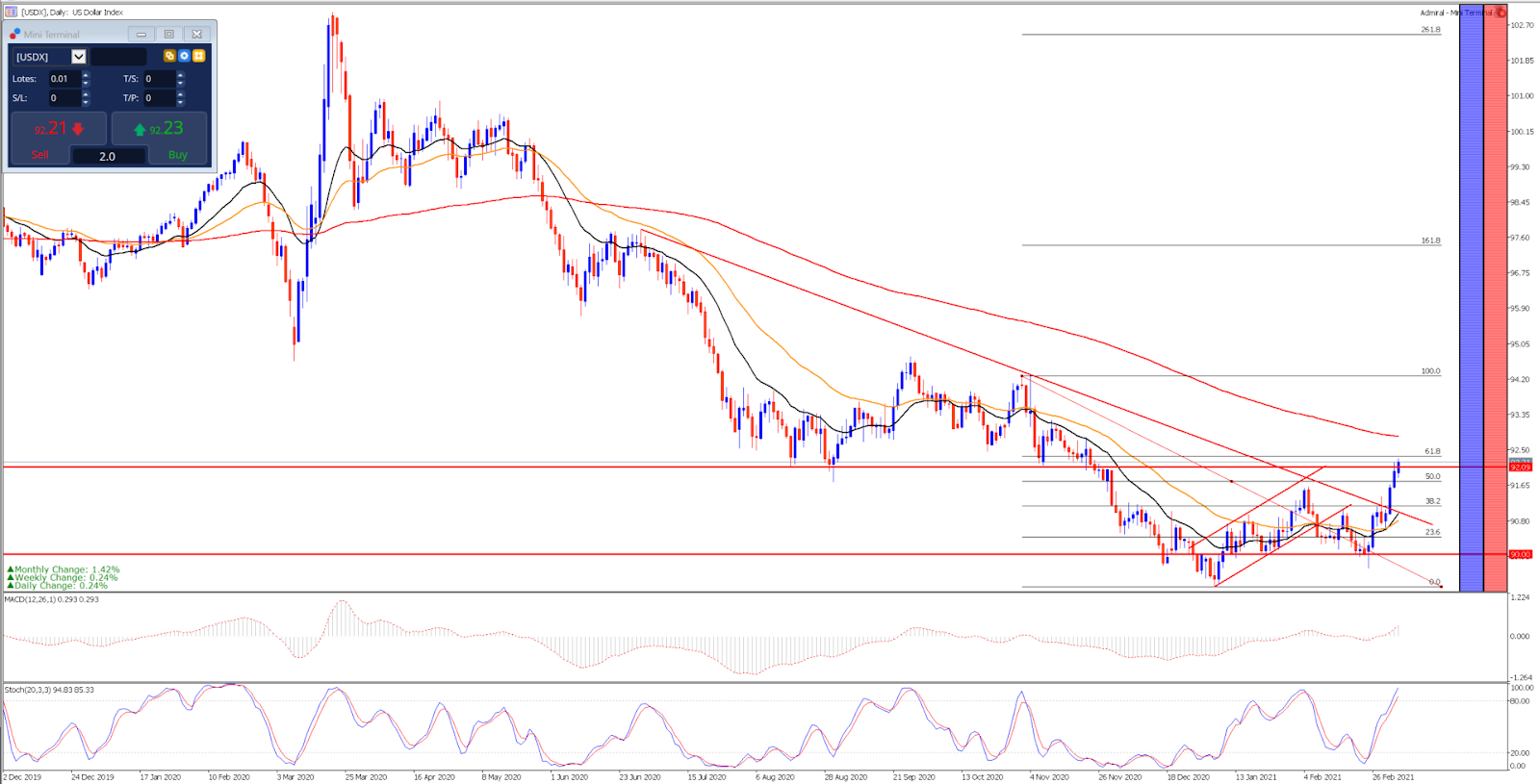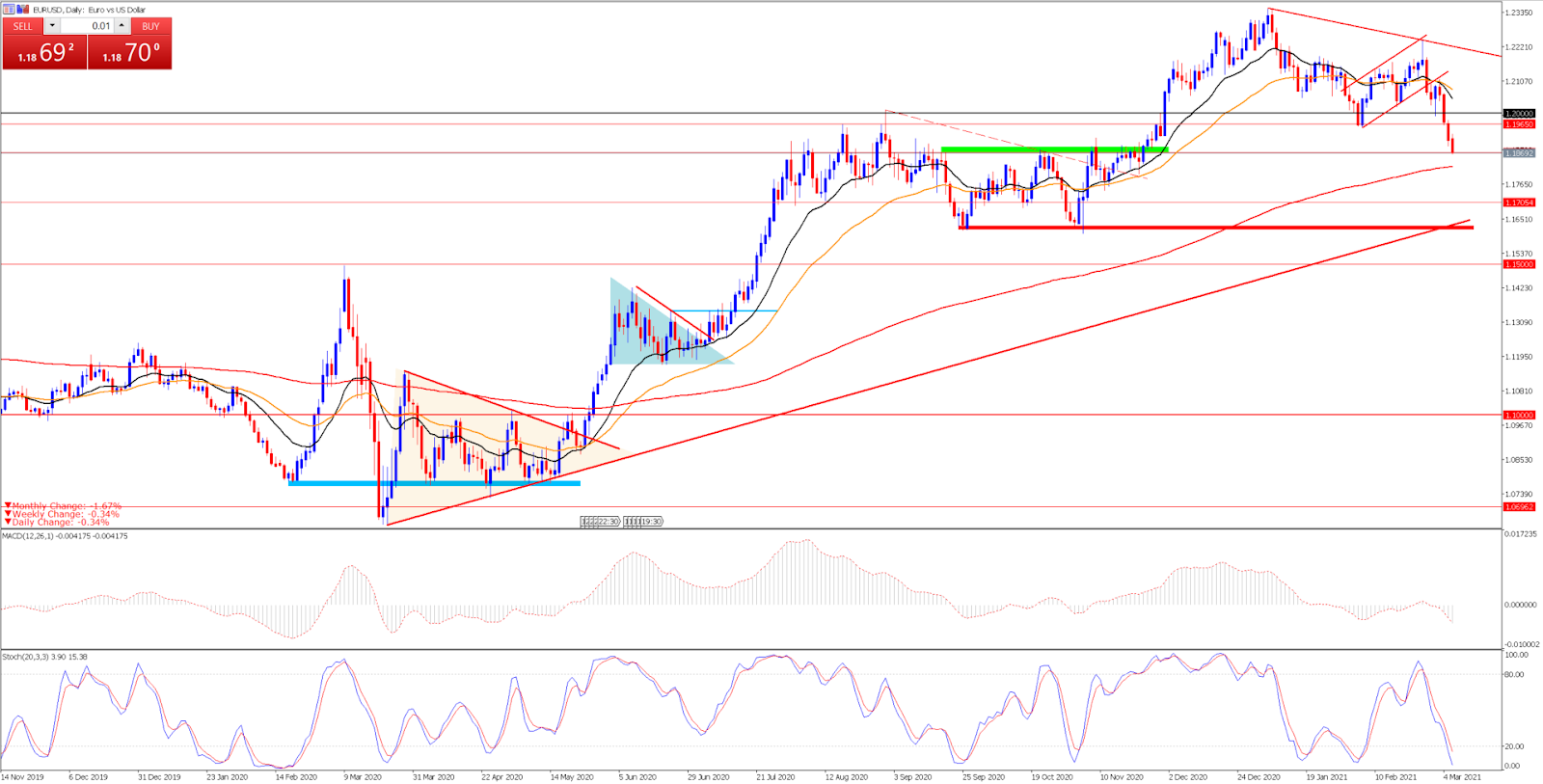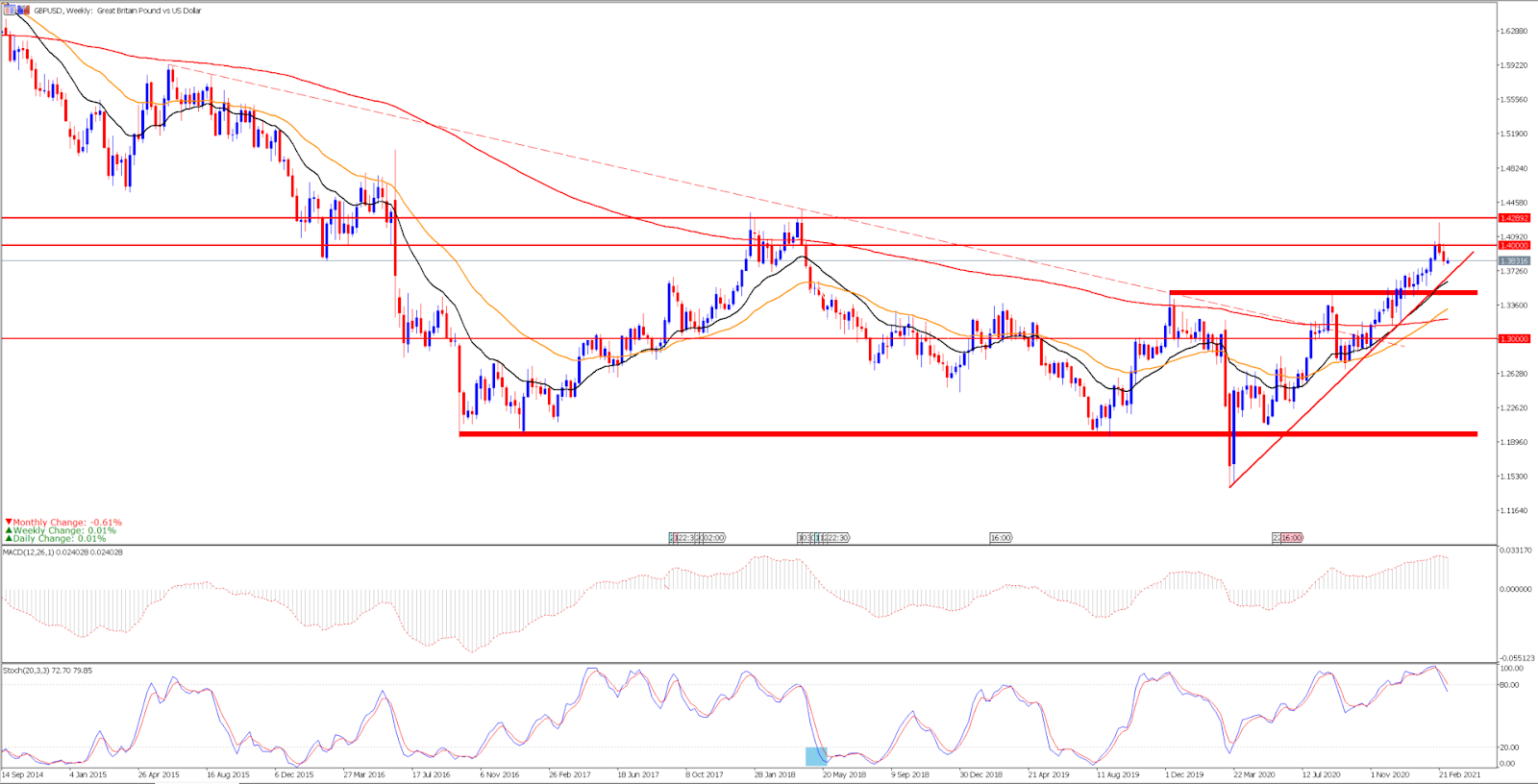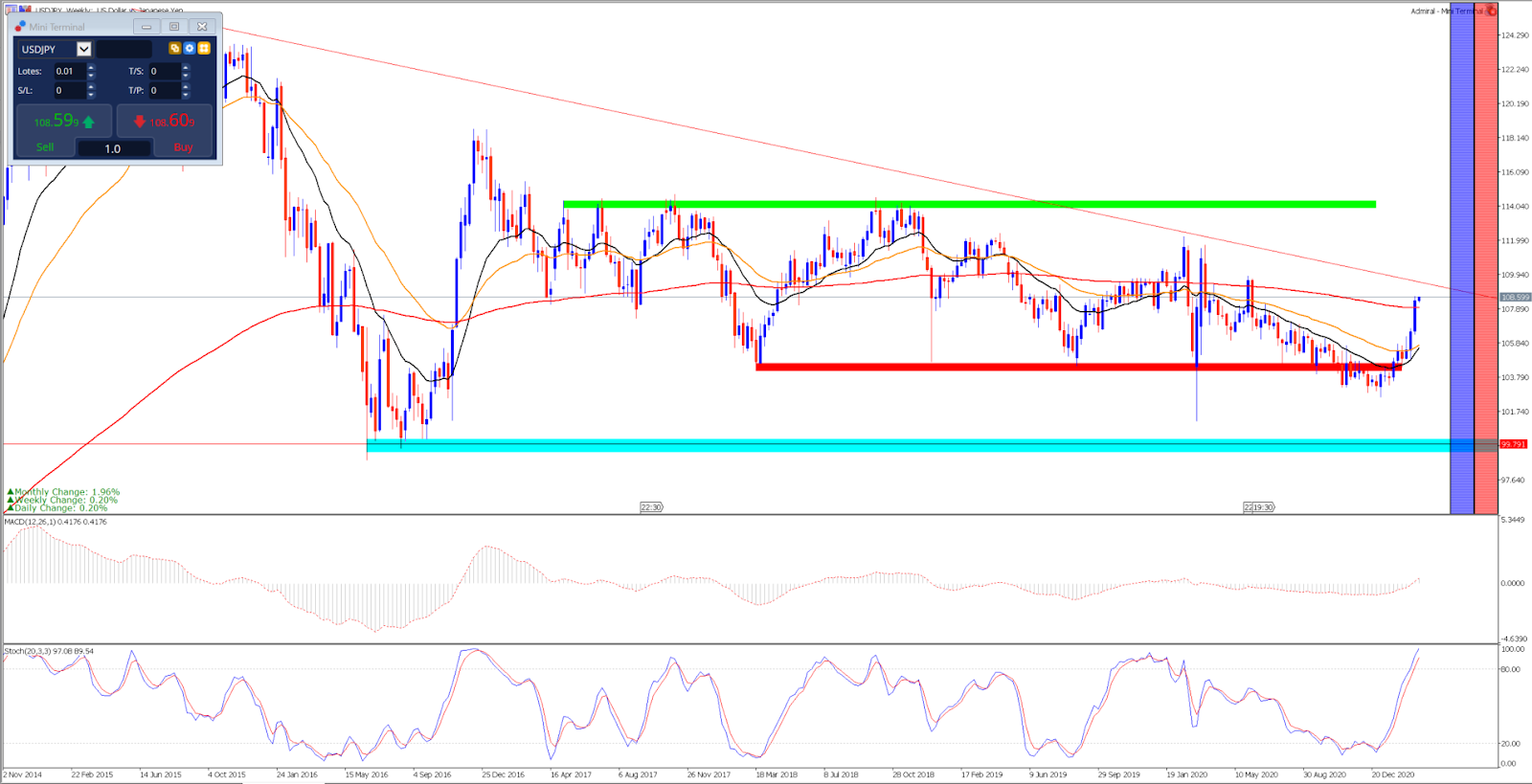In February we noted that the dollar index had lost ground against the major currencies, after enjoying a positive month in January, which had been preceded by a year of weakness for the US dollar in 2020. During the last few sessions, the dollar index has shown strength at its important support level of 90.00 USD and experienced a strong rally.
During January, this rally was mainly due to increased volatility in the stock markets during the second half of the month and to uncertainty related to the pandemic which caused monthly declines in virtually all the major indices, with the exception of the Nasdaq, thus encouraging the use of the USD as a safe haven asset.
In the past few days, we have seen very similar behaviour in the global benchmark currency. As the sharp rise in US bond yields has caused stock markets to suffer declines, investors are, once again, seeking refuge in the US dollar.

Source: Admiral Markets MetaTrader 5 – USD Index Daily Chart. Date Range: 2 November 2019 – 8 March 2021. Date Captured: 8 March 2021. Past performance is not necessarily an indication of future performance.
This rally in the dollar index has caused a break through the medium-term red bearish trend line, thus overcoming the 92.00 USD level. We will have to watch the evolution of this index in the coming sessions and see if it is able to maintain this important level and look for its 200 session average in red which currently acts as its main resistance.
EURUSD Analysis
Last week was marked by rising US bond yields and positive US employment data which showed strong job creation with non-farm payrolls at 379,000, versus the expected 182,000, causing the US dollar to appreciate sharply.
Technically speaking, after making a pullback earlier in the week following the bearish break of the bullish channel, price fell sharply during Thursday and Friday’s sessions until losing the important support level at 1.20.
At the moment the week is starting with declines, causing the price to look for the price level of the upper green band of its sideways channel. This week, it is important to see if the price is able to hold this level and recover or if it finally decides to continue its downtrend to its 200 session average.
The loss of this support level could lead to further declines and see the price to look for its next support level at the meeting point of the red band and the uptrend line.

Source: Admiral Markets MetaTrader 5 – EURUSD Daily Chart. Date Range: 14 November 2019 – 8 March 2021. Date Captured: 8 March 2021. Past performance is not necessarily an indication of future performance.
Price evolution of the last five years:
- 2020 = +8.93%
- 2019 = -2.21%
- 2018 = -4.47%
- 2017 = +14.09%
- 2016 = -3.21%
GBPUSD Analysis
We can see that the GBPUSD has been following a very clear uptrend since the low of 20 March 2020, around the level of 1.14100, until almost reaching the level of 1.42300, which has led it to overcome its long-term downtrend line (in red dotted).
As we can see in the weekly chart, after making highs in February, as with the EURUSD, the price has started a correction that has led it to lose the important level of 1.40 and drop to 1.39350.
This bearish movement may cause the price to look for its current support levels at the uptrend line and the 18-session average in black, thus relieving the overbought level of recent weeks.

Source: Admiral Markets MetaTrader 5 – GBPUSD Weekly Chart. Date Range: 14 September 2014 – 8 March 2021. Date Captured: 8 March 2021. Past performance is not necessarily an indication of future performance.
Price evolution of the last five years:
- 2020 = +3.10%
- 2019 = +3.95%
- 2018 = -5.54%
- 2017 = +9.43%
- 2016 = -16.26%
USDJPY Analysis
Finally, if we look at the USDJPY, we can see how the Japanese yen has lost ground against the US dollar after its latest rally.
As we can see in the weekly chart below, after a long time facing its important support level (represented by the red band), the price has decisively bounced back above the 200 average in red.
The break of this level, may lead the price to tackle its bearish trend line which currently acts as the first resistance. A break above this level could open the door to a bullish rally to the top of the sideways channel in green.
It is important to analyse the price action in the coming sessions, as if the price is not able to hold the break of the 200-average it could experience a further pullback.

Source: Admiral Markets MetaTrader 5 – USDJPY Weekly Chart. Date Range: 2 November 2014 – 8 March 2021. Date Captured: 8 March 2021. Past performance is not necessarily an indication of future performance.
Price evolution of the last five years:
- 2020 = -4.95%
- 2019 = -0.88%
- 2018 = -2.76%
- 2017 = -3.59%
- 2016 = -2.85%
Trade Forex With Admiral Markets
With the Trade.MT5 account from Admiral Markets, you can trade Contracts For Difference (CFDs) on EURUSD, GBPUSD, USDJPY and many other currency pairs 24 hours a day, 5 days a week! CFDs allow traders to attempt to profit from both rising and falling prices, as well as benefiting from the use of leverage. Click the banner below to open an account today:
INFORMATION ABOUT ANALYTICAL MATERIALS:
The given data provides additional information regarding all analysis, estimates, prognosis, forecasts, market reviews, weekly outlooks or other similar assessments or information (hereinafter “Analysis”) published on the websites of Admiral Markets investment firms operating under the Admiral Markets trademark (hereinafter “Admiral Markets”) Before making any investment decisions please pay close attention to the following:
- This is a marketing communication. The content is published for informative purposes only and is in no way to be construed as investment advice or recommendation. It has not been prepared in accordance with legal requirements designed to promote the independence of investment research, and that it is not subject to any prohibition on dealing ahead of the dissemination of investment research.
- Any investment decision is made by each client alone whereas Admiral Markets shall not be responsible for any loss or damage arising from any such decision, whether or not based on the content.
- With view to protecting the interests of our clients and the objectivity of the Analysis, Admiral Markets has established relevant internal procedures for prevention and management of conflicts of interest.
- The Analysis is prepared by an independent analyst, Roberto Rojas (analyst), (hereinafter “Author”) based on their personal estimations.
- Whilst every reasonable effort is taken to ensure that all sources of the content are reliable and that all information is presented, as much as possible, in an understandable, timely, precise and complete manner, Admiral Markets does not guarantee the accuracy or completeness of any information contained within the Analysis.
- Any kind of past or modeled performance of financial instruments indicated within the content should not be construed as an express or implied promise, guarantee or implication by Admiral Markets for any future performance. The value of the financial instrument may both increase and decrease and the preservation of the asset value is not guaranteed.
- Leveraged products (including contracts for difference) are speculative in nature and may result in losses or profit. Before you start trading, please ensure that you fully understand the risks involved.

